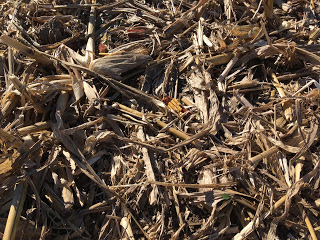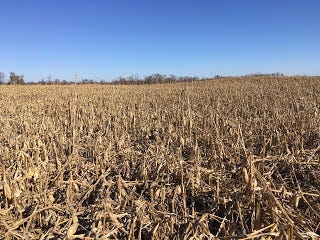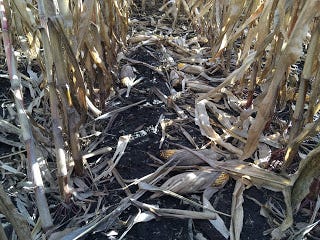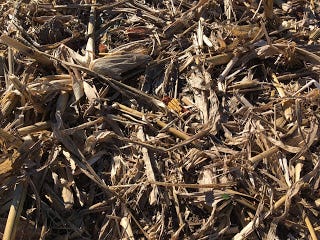October 31, 2018

Source: University of Minnesota Extension
By Dave Nicolai, Liz Stahl and Jeff Gunsolus
The 2018 corn growing season was challenging for Minnesota growers. Excessive precipitation in some areas of the state and dry conditions in others, along with wind storms and tornadoes, has taken its toll on consistency in corn yields. The weather, along with disease and the early dying of some corn hybrids, has led to limited stalk strength at harvest. As a result, we expect the occurrence of volunteer corn to be greater in areas of the state in 2019 due to a higher potential for corn ears and kernels to be left in the field this fall.

Severely lodged corn field in Rice County.
Downed corn from wind storms, along with typical harvest losses, can contribute to widespread problems with volunteer corn in fields. Volunteer corn has the potential to reduce crop yield as well as impact the long-term management of corn rootworm (CRW).
Sources of corn grain losses
Sources of grain losses can be broadly divided into pre-harvest losses, gathering losses and machine losses. Remember that every two kernels per square foot equals one bushel of loss per acre.
Pre-harvest losses
Some losses can occur before the combine even reaches the field. Hybrids differ in their ability to retain grain on the plant due to maturity and ear droppage. As a guideline, one ear (3/4 pound each) in each 1/100 of an acre is equivalent to one bushel per acre. To determine 1/100 of an acre, take the normal 1/1,000 acre distance times ten. For example, in 30-inch rows, 1/1000 of an acre is 17 feet 5 inches of row; 1/100 acre would be that distance across ten rows. Ear droppage can occur even when plants remain upright.

Corn ears that dropped in a Rice County corn field.
Gathering and machine losses
Gathering losses occur at the front end of the combine and include ears missed or dropped by the head and loose kernels that don’t make it into the combine To determine gathering loses, count the number of ears and kernels under the header. More than a half bushel per acre (or one kernel per square foot average) indicates adjustments would be appropriate. Machine losses occur from improper adjustment of threshing, separating and cleaning sections, and can be determined by looking behind the combine. For more information on determining and measuring these losses, visit the Grain harvesting website at the University of Wisconsin.

Partial corn cobs left after combine harvest in Rice County.
How much does volunteer corn impact crop yields?
Volunteer corn can significantly reduce soybean and corn yield, although research shows volunteer corn is less competitive in corn than in soybean. For example, volunteer corn populations ranging from 800 to 13,000 plants per acre resulted in yield losses of 0 to 54 percent in soybean and 0 to 13 percent in corn (South Dakota State University). In University of MN trials, volunteer corn populations had to reach at least 8,000 plants/acre before yield was reduced an average of 8 percent.
Clumps of volunteer corn (plants emerging from dropped ears) are more competitive than individual plants. For example, University of Nebraska researchers found that in soybean, 3,500 clumps of corn per acre reduced yield 40 percent while the same population of individual plants reduced yield 10 percent.
Even though volunteer corn in corn could potentially help offset yield losses by contributing to yield, volunteer corn typically lags behind hybrid corn in development, and when ears are produced, they are often smaller with poor seed set, particularly at high populations.
Volunteer corn can impact corn rootworm (CRW) management
Most of the hybrid corn planted today carries traits for resistance to insects such as CRW. Crop rotation is one tool to help manage CRW, but any benefit is essentially nullified if a heavy population of volunteer corn is present in soybean. CRW larvae are able to feed and mature on uncontrolled volunteer corn. Also, late- pollinating volunteer corn is very attractive as a feeding and egg-laying site for CRW beetles, creating the potential for CRW problems the following year.
Volunteer plants of Bt-CRW hybrids will also express the Bt toxin at variable and reduced levels. Exposure of CRW larvae to sub-lethal doses of the Bt toxin has the potential to hasten development of resistance to Bt-CRW traits. More details on this issue can be found in Control volunteer corn for yield protection and corn rootworm management.
Selective use of fall tillage can affect the amount of volunteer corn next year
Following harvest, if a grower has a field where lodging, ear drop or shelling at the head were significant, adjusting the fall tillage strategy can help mitigate volunteer corn the following season. Allowing seed to stay on the soil surface may reduce populations the following season by allowing germination in the fall prior to freezing temperatures. Seed left on the surface is also much more susceptible to predation or decay. No-till extends the benefit of no fall tillage. By not incorporating seed into the soil, it is left on the soil surface where it is much less likely to result in successful germination and emergence.
Using postemergence herbicides in 2019 for volunteer corn control
The remainder of this article is reprinted and edited with permission by Dr. Amit Jhala, University of Nebraska Weed specialist and Jenny Rees, Extension educator, at the University of Nebraska-Lincoln. To see the full article from June 1,2018, visit Control of volunteer corn in soybeans and corn.
Control of volunteer corn in soybean
Control of volunteer corn in soybean is easier because a number of graminicides (grass herbicides), such as Select Max, Poast, Assure II, Fusilade, and Fusion are labeled for this use. For more information on application rates of grass herbicides for control of volunteer corn in Roundup Ready or Xtend soybean, see Volunteer corn in soybean: Impact and management.
LibertyLink soybean is also available in the marketplace and Liberty can control volunteer corn, but ONLY if the hybrid corn planted last year was NOT LibertyLink-resistant. Liberty is a nonselective, contact, post emergence herbicide for broad-spectrum weed control in LibertyLink soybean. An update to the Liberty label allows a maximum cumulative rate of 87 fl oz/acre per growing season. Two applications, each of 32 to 43 fl oz/acre, could be made in LibertyLink soybean.
For more information on application rates of Liberty for control of volunteer corn, see Control of glyphosate-resistant volunteer corn in LibertyLink soybean.
Remember that Liberty can only be applied in LibertyLink soybean, NOT in conventional, Roundup Ready or Roundup Ready 2Xtend soybean. Application of graminicides (Assure II, Select Max, Poast, Fusilade, Fusion) will be the only option for controlling volunteer corn in conventional, Roundup Ready or Roundup Ready 2Xtend soybean. See Volunteer corn in soybean: Impact and management for more information.
Control of volunteer corn in corn
Control of volunteer corn in continuous corn is difficult because volunteer corn is also selective to corn herbicides.
If only a Roundup Ready corn hybrid was planted the previous year and Roundup Ready + LibertyLink hybrid corn is planted this year, Liberty can be applied for control of glyphosate-resistant volunteer corn. Two applications, each of 32 to 43 fl oz/acre, could be made in LibertyLink corn.
Remember that Liberty will NOT be effective if Roundup Ready + Liberty Link hybrid corn was planted last year.
Control of volunteer corn in Enlist corn
Enlist™ Corn is a new multiple herbicide-resistant corn. Enlist corn is resistant to 2,4-D choline, glyphosate, and aryloxyphenoxypropionates (FOPs). Enlist corn was commercially available for the first time for the 2018 growing season. If Enlist corn is grown in 2019 in a field that was under conventional or Roundup Ready/LibertyLink corn last year, volunteer corn can be controlled by applying the "FOP" herbicide, Assure® II.
Assure® II is currently the only grass herbicide labeled to control volunteer corn in Enlist Corn. It can be applied at 5 to 12 fl oz/acre in Enlist Corn for selective control of volunteer corn. Assure® II must include crop oil concentrate (1% v/v) or nonionic surfactant (0.25% v/v). Apply Assure® II to emerged Enlist™ field corn that is at the V2 through V6 stage of development.
In fields where Enlist Corn was grown in 2018 and volunteer corn is a concern, only Liberty applied to corn with the Liberty Link trait should be planted in 2019.
Remember that Assure II can NOT be applied in Roundup Ready/LibertyLink corn. To know more about application requirements of Assure II, see the product label.
Originally posted by the University of Minnesota Extension.
You May Also Like




